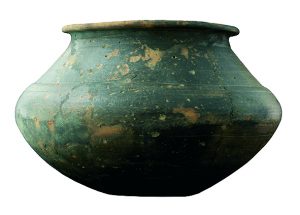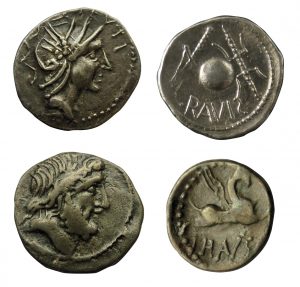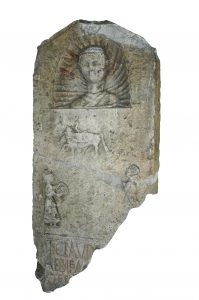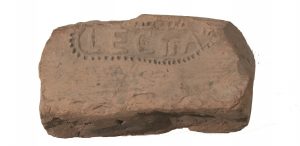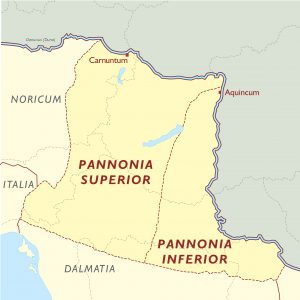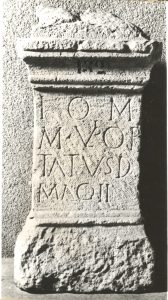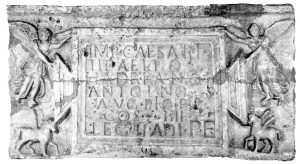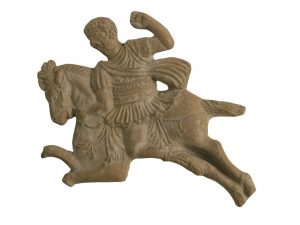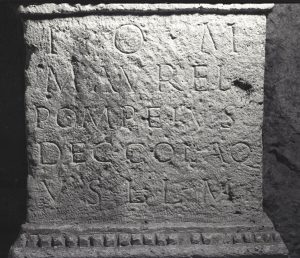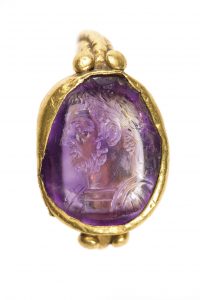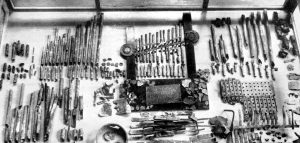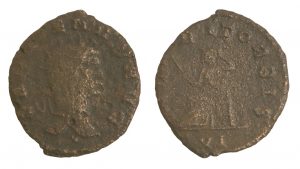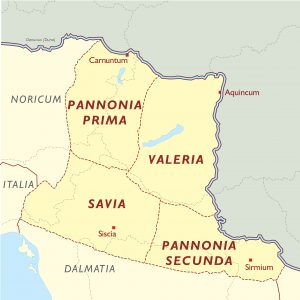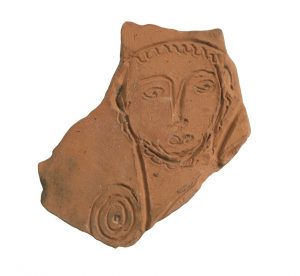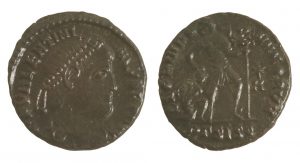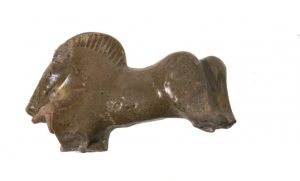17 key milestones: from the Celts to the Hunnic period. Explore Aquincum’s history.
|
4th-3rd CENTURY BC Celts settle in the Carpathian basin
|
|
|
|
Light brown, wheel-thrown, biconical, Celtic period urn with a bulging shoulder, a narrowing neck and thickened, everted rim. The shoulder is decorated with horizontal smoothing (3rd-2nd century BC).
Find-spot: Budapest, District XXI. Csepel Sewage treatment facility (Celtic period cemetery) |
|
1st CENTURY BC The Celtic tribe of the Eravisci in the modern-day counties of Pest, Fejér and Tolna. Their centre is the hilltop fortified settlement (oppidum) on Gellért Hill. |
|
|
|
Eraviscan silver denarii from the 1st century BC. The tribe’s name appears as RAVIS and IRAVIS.
Find-spot: Budapest, District XI. Gellért Square |
|
CLAUDIUS around AD 49 Extension of Roman control until the Danube bend. Organisation of the province of Pannonia. The ala Hispanorum I is garrisoned in Víziváros (the earliest known Roman military base in Budapest).
|
|
|
|
Grave stele of cavalry soldier T. Claudius, who served at the Víziváros base.
Find-spot: Budapest, District II. near the Császár Baths, Frankel Leó Street |
|
DOMITIAN AD 89 The Legio II Adiutrix builds a permanent base in Óbuda. Short interruptions aside, the legion remains here until the early 5th century.
|
|
|
|
Later cut from a larger tile, this roof tile (tegula) carries the mark of the LEG(ionis) II A(diutrici) in a so-called planta pedis stamp. (End of the 1st century AD – 2nd century AD).
Find-spot: Budapest, District III. Flórián Square (2nd-3rd century legionary fortress)
|
|
TRAJAN AD 106 Division of the province into Upper and Lower Pannonia. Aquincum becomes the seat of Pannonia Inferior. Also under Trajan: construction of the north-south aqueduct; start of urban development on the site of the Civil Town.
|
|
|
|
Division of Pannonia after AD 106. Seat of Upper Pannonia: Carnuntum, seat of Lower Pannonia: Aquincum. |
|
HADRIAN around AD 124 The Civil Town gains municipium status, town walls are built. Also under Hadrian: the Aquincum legionary base is rebuilt in stone.
|
|
|
|
Altar dedicated by Marcus Ulpius Optatus councillor (decurio) and ‘mayor’ (duumvir) of the Aquincum municipium to Jupiter Best and Greatest.
I(ovi) O(ptimo) M(aximo) / M(arcus) Ulp(ius) Op/tatus d(ecurio) / m(unicipii) Aq(uinci) II [vir]
Find-spot: Budapest, District XII. Diósárok |
|
ANTONINUS PIUS AD 145 Construction of the Military Town amphitheatre.
|
|
|
|
Building inscription of the military amphitheatre. The tablet with the inscription is held by Victoria, the winged goddess of Victory on either side, with a Pegasus, the insignia of the Legio II Adiutrix underneath.
Imp(eratori) Caesari / Tit(o) Aelio / Hadriano / Anto(n)ino Pio p(atri) p(atriae) / co(n)s(uli) IIII leg(io) II Adi(utrix) p(ia) f(idelis).
To the Emperor Titus Aelius Hadrianus Antoninus Pius, father of the fatherland, consul for the fourth time. The Loyal and Faithful Legio II Adiutrix.
Find-spot: Budapest, District III. Viador Street |
|
MARCUS AURELIUS AD 167-180 War against the Marcomanni, Quadi and Sarmatians on the Pannonian limes.
|
|
|
|
The clay model used to create moulds for celebratory cakes depicts the riding Emperor Marcus Aurelius (second half of the 2nd century AD).
Find-spot: Budapest, District III. Óbuda Gasworks (the Civil Town’s eastern pottery workshop)
|
|
SEPTIMIUS SEVERUS AD 194 The Aquincum Military Town and Civil Town receives the rank of colonia together. The reign of the Severan dynasty marks the golden age of Aquincum.
|
|
|
|
Altar dedicated by a councillor (decurio) of the colonia.
I(ovi) O(ptimo) M(aximo) M(arcus) Aurel(ius) Pompeius dec(urio) col(oniae) Aq(uinci) v(otum) s(olvit) l(ibens)l(aetus) m(erito).
To Jupiter Best and Greatest. Marcus Aurelius Pompeius, decurio of the colonia of Aquincum fulfilled his vow willingly, happily and deservedly.
Find-spot: Budapest, District III. Óbuda |
|
CARACALLA AD 214 Border adjustment between Upper and Lower Pannonia. Brigetio and the Legio I Adiutrix stationed there are allocated to Lower Pannonia. Aquincum becomes the seat of a province with two legions.
|
|
|
|
Gold ring with an amethyst gem attached to it, featuring a portrait of the Emperor Caracalla, facing left (3rd century AD).
Find-spot: Budapest, District III. Bécsi Road (Roman period cemetery) |
|
ALEXANDER SEVERUS AD 228 Caius Iulius Viatorinus presents the collegium centonariorum with an organ (hydra).
|
|
|
|
Parts of the world-famous Aquincum organ, unearthed in 1931. Its bronze dedicatory inscription tells us that Caius Iulius Viatorinus, councillor of the colonia of Aquincum, former aedile, and prefect of the association of textile dealers (collegium centonariorum) gave this organ to the aforementioned association in the consulship of Modestus and Probus (AD 228).
Find-spot: Budapest, District III. Szentendrei Road (On the site of the Aquincum Museum’s new exhibition building) |
|
GALLIENUS AD 260 Attack by the Quadi, Roxolani and Sarmatians on the Pannonian limes. Signs of destruction in the legionary fortress, Military Town and Civil Town.
|
|
|
|
Antoninianus (bronze coin containing only a small amount of silver) of the Emperor Gallienus.
Obverse: Bust of the emperor with a radial crown, facing right, surrounded by the inscription GALLIENVS AVG.
Reverse: A seated Securitas holding a sceptre in her right hand, and raising the left to her head, surrounded by the inscription: (SEC)VRIT ORBIS (AD 260-268).
Find-spot: Budapest, District III. Aquincum
|
|
DIOCLETIAN AD 294 As part of an administrative reform, Pannonia is divided into four parts. Aquincum becomes the military centre of the province of Valeria and the base of the province’s military commander (dux).
|
|
|
|
Re-division of Pannonia into the provinces of Pannonia Prima, Secunda, Savia and Valeria. |
|
CONSTANTINE I around AD 332 Under Constantine the Great, the Late Roman fortress is constructed.
|
|
|
|
Roof tile fragment incised before firing with the portrait of a man wearing a disc fibula (possibly an emperor, or even Constantine the Great) (4th century AD).
Find-spot: Budapest, District III. Záhony Street (just south of the Civil Town) |
|
VALENTINIAN I AD 375 Construction of a chain of small forts and watchtowers in the Danube bend. Reinforcement of the limes in Aquincum. The size of the Late Roman fortress is reduced.
|
|
|
|
Bronze coin of the Emperor Valentinian I.
Obverse: Bust of the emperor, wearing a pearl diadem and a paludamentum cloak, facing right, surrounded by the inscription DN VALENTINIANVS PF AVG.
Reverse: The emperor holding a labarum military standard, striking a kneeling barbarian, surrounded by the inscription GLORIA ROMANORVM (AD 337-341).
Find-spot: Budapest, District III. Aquincum
|
|
LATE-4TH CENTURY AD Depopulation of the Civil Town. The remaining civilian population of the Military Town moves within the Late Roman fortress.
|
|
|
|
Fragment of a horse-shaped, green-glazed statuette, which originally formed part of an oil lamp with legs. The use of lead glaze in pottery becomes common at the end of the 3rd century AD. The new products include horse-shaped, glazed ceramic candle and oil-lamp holders (3rd -4th century AD).
Find-spot: Budapest, District III. Óbuda Gasworks |
|
VALENTINIAN III AD 433 Pannonia is ceded to the Huns.
|
|
|
|
Reconstruction of a diadem made from gold plates with a garnet inlay unearthed in a man’s grave from the Hunnic period.
Find-spot: Budapest, District XIV., Vezér Road |
